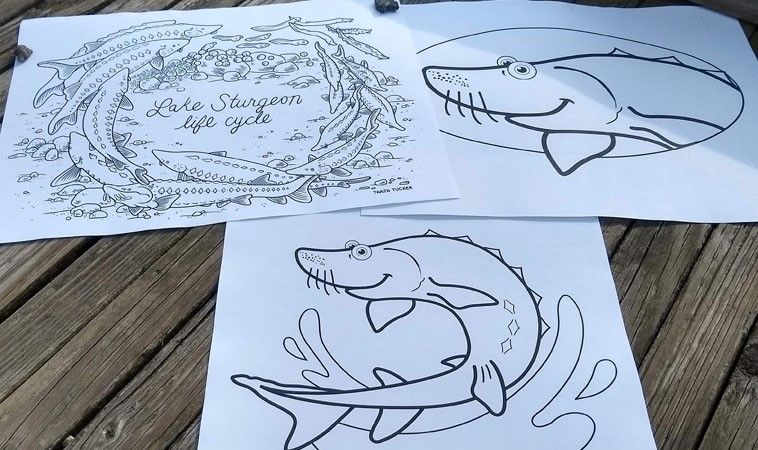Good News in Conservation Effort for “Living Fossil” Fish
by: Kara Lynn Dunn
There’s good news in the effort to restore the lake sturgeon to the fresh waters of the Great Lakes-St. Lawrence River system. This fish is often called a “living fossil fish”, because of its prehistoric appearance and longevity.
The June 2019 issue of Thousand Islands Life highlighted efforts to restore the lake sturgeon (Acipenser fulvescens) to New York’s fresh waters, from the St. Lawrence River and Lake Ontario, to the Niagara River, Lake Erie, inland waters, and canals. The once abundant populations of this fish declined until the lake sturgeon was designated a New York State Threatened Species in 1983.
The Ontario Ministry of Natural Resources designates the lake sturgeon’s status as a Species at Risk, Species of Special Concern, Threatened, or Endangered, depending upon the specific body of water. It is listed as Threatened in the Upper St. Lawrence River and in Northwestern Ontario.
Recent milestones for lake sturgeon conservation in New York waters have generated new excitement and support for sturgeon research, stocking efforts, and educational outreach by New York State, federal (U.S. and Canadian), provincial, Tribal, academic, and nonprofit entities.
In May 2021, U.S. Geological Survey (USGS) Research Ecologist Dawn Dittman, Ph.D., captured and released a 61-inch, almost 70-pound, female lake sturgeon in the Genesee River, 18 years after it was stocked in the river as a juvenile fish. This was the first confirmation of a reproductively-active sturgeon that had been previously stocked in the Genesee River by the lake sturgeon restoration research team.
Three days after the Genesee River discovery, Cornell University fisheries researchers captured and released a lake sturgeon identified as the largest fish ever recorded in Oneida Lake. The 73.6-inch fish weighed 159.4 pounds and is believed to be 26 years old, one of the sturgeon stocked into the lake in 1995.

“The lake sturgeon is a species of concern across all of the Great Lakes Basin. It is the largest and longest-lived native fish throughout the basin, and it is an indicator of the overall health of the ecosystem. It is very exciting to be able to document this 18-year-old female with mature eggs near the spawning habitat in the Genesee River,” Dittman said.
The USGS, with partners, also tracks spawning activity by the natural populations of lake sturgeon in the greater Thousand Islands region of New York State, the USGS has documented activity in the St. Lawrence River, on the Iroquois Dam improved spawning beds, in the Black River, and at the mouth of the Oswegatchie River.


New Lake Sturgeon Educational Resources
With a grant from the Disney Conservation Fund, New York Sea Grant developed a suite of lake sturgeon conservation and education resources, including a Lake Sturgeon Intermediate Curriculum and video freely accessible online at www.nyseagrant.org/lakesturgeon.
New York Sea Grant’s Great Lakes Fisheries and Ecosystem Health Specialist Stacy Furgal notes, “New York Sea Grant’s suite of lake sturgeon resources serve as a springboard into the world of science, environmental stewardship, and STEM (science, technology, engineering and mathematics) careers, by featuring this charismatic and threatened species that is so important to the Great Lakes-St. Lawrence River region.”
New York Sea Grant’s Great Lakes Coastal Literacy Specialist Nate Drag notes, “To broaden the reach of the curriculum to all grade levels, input from teachers participating in two curriculum development workshops is incorporated throughout the 10 lesson plans, to encourage skill development in reading and comprehension, mathematics, ecology, graphing, history, and the arts.”
A “Sturgeon Sack” of curriculum collateral teaching materials, which includes digital worksheets, field sampling equipment, a fish tracking tag, and the “Tale of a Great White Fish” book, about a fish facing survival challenges similar to those threatening the lake sturgeon, is available on loan. Interested teachers can contact Drag, who also serves as Associate Director of the Great Lakes Program at the University at Buffalo, at the New York Sea Grant office in Buffalo: 716-645-3610, nwd4@cornell.edu.


Special Note:
The fishing of lake sturgeon is still prohibited in New York. If an angler should catch a lake sturgeon, it must be returned to the water. For more information on the New York State Lake Sturgeon Recovery Plan, please see https://www.dec.ny.gov/outdoor/111557.html. For fishing regulations for the Canadian provinces, see https://www.dfo-mpo.gc.ca/fisheries-peches/recreational-recreative/regs-eng.html.

By Kara Lynn Dunn, 315-465-7578, karalynn@gisco.net
Kara Lynn Dunn is the publicist for the New York Sea Grant Great Lakes Program and the Great Lakes Research Consortium. She lives in Mannsville, NY, with her husband, photographer Brian Whattam, who grew up in Three Mile Bay, NY. We suggest you take the time to read Kara's other TI Life articles in three places: here, here and here.






Please click here if you are unable to post your comment.